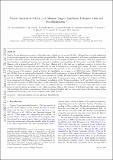Analysis in the visible range of NASA Lucy mission targets: Eurybates, Polymele, Orus and Donaldjohanson.
Author(s)
Souza-Feliciano, A.C.; De Prá, M.; Pinilla-Alonso, N.; Alvarez-Candal, A.; Fernández-Valenzuela, E.; Binzel, Richard P.; De León, J.; Arcoverde, P.; Rondón, E.; Evangelista, M.S; Souza-Feliciano, A.C.; ... Show more Show less
DownloadSubmitted version (856.5Kb)
Publisher with Creative Commons License
Publisher with Creative Commons License
Creative Commons Attribution
Terms of use
Metadata
Show full item recordAbstract
Jupiter Trojan asteroids are minor bodies that share Jupiter's orbit around the Sun. Although not yet well understood in origin and composition, they have surface properties that, besides being comparable with other populations of small bodies in the Solar System, hold information that may restrict models of planetary formation. Because of this, there has been a significant increase in the interest in studying this population. In this context arises the NASA Mission Lucy, with a planned launch in 2021. The Lucy Mission will be the first one to address a group of six objects (five Jupiter Trojans and one main belt asteroid) with the aim of investigating, in detail, their nature. In order to provide valuable information for mission planning and maximize the scientific return, we carried out ground based observations of four targets of the mission. Aimed at looking for variabilities on the spectra of (3548) Eurybates, (15094) Polymele and (21900) Orus, we performed rotationally resolved visible spectroscopy of them at SOAR Telescope. We also analyzed the first visible spectrum obtained for the main belt asteroid (52246) Donaldjohanson at Gran Telescopio Canarias. The spectra of (21900) Orus and (15094) Polymele present here are the first ones in the visible range and show rather homogeneous characteristics along the surfaces. Their taxa correspond with those of the two dominant Trojan populations, the P- and the D-type group of objects. Spectroscopy of (3548) Eurybates, on the other side, suggests that some variation on the characteristics of the reflectance of this body. Donaldjohanson shows hints of hydrated materials in its visible spectrum. The Lucy mission will investigate the surface composition of these targets and will shed light on their connections with other populations of minor bodies and on their role in the evolution of the Solar System. ©2020
Date issued
2020-03Department
Massachusetts Institute of Technology. Department of Earth, Atmospheric, and Planetary SciencesJournal
Icarus
Publisher
Elsevier BV
Citation
Souza-Feliciano, A.C., et al., "Analysis in the visible range of NASA Lucy mission targets: Eurybates, Polymele, Orus and Donaldjohanson." Icarus 338 (Mar. 2020): no. 113463 doi 10.1016/j.icarus.2019.113463 ©2020 Author(s)
Version: Original manuscript
ISSN
0019-1035
Keywords
Space and Planetary Science, Astronomy and Astrophysics